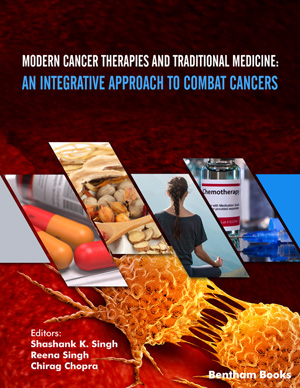
Abstract
Background: Lung cancer is the second most lethal type of cancer, with a poor survival rate of 5 years. It is one of those malignant tumors that has grown most rapidly in the context of mortality and morbidity.
Aim: This review article aims to provide insight into current nanotechnological approaches taken into consideration that provide advantages over conventional chemotherapy.
Results and Discussion: After comparing conventional chemotherapy and nanotechnology-based therapies for lung cancer, the results showed that recent advances in nanomaterials proved to be more effective in lung cancer diagnosis, mitigation and treatment. Here, Surface-engineered smart nanocarrier- based inhalations, Bio-nanocarriers for lung cancer, gas plasma nanoparticles, and magnetic nanoparticles are discussed.
Conclusion: After summarizing these nanomaterials, investigators concluded that the in-vivo and invitro effectiveness of recently developed nanoparticles was found to be better than that of conventional nanoparticles.
Graphical Abstract
[http://dx.doi.org/10.1016/j.jcrpr.2017.07.001]
[http://dx.doi.org/10.3322/caac.21763] [PMID: 36633525]
[http://dx.doi.org/10.1016/j.pharmthera.2019.02.010] [PMID: 30796927]
[http://dx.doi.org/10.1038/nature13385] [PMID: 25079552]
[http://dx.doi.org/10.1038/ncomms5846] [PMID: 25204415]
[http://dx.doi.org/10.1016/j.cell.2014.06.049] [PMID: 25109877]
[http://dx.doi.org/10.1183/09031936.00014009] [PMID: 19483050]
[http://dx.doi.org/10.7759/cureus.513] [PMID: 27026837]
[http://dx.doi.org/10.3389/fonc.2022.877594] [PMID: 35992832]
[http://dx.doi.org/10.1016/S0140-6736(98)90327-0] [PMID: 9606361]
[http://dx.doi.org/10.1016/j.ejphar.2014.07.025] [PMID: 25058905]
[http://dx.doi.org/10.1038/bjc.1968.34] [PMID: 5660132]
[http://dx.doi.org/10.1111/j.1365-2184.1979.tb00111.x] [PMID: 421240]
[http://dx.doi.org/10.4236/jct.2011.23045]
[http://dx.doi.org/10.1016/j.nano.2009.04.008] [PMID: 19447208]
[PMID: 34104817]
[http://dx.doi.org/10.1016/j.biomaterials.2008.03.033] [PMID: 18436301]
[PMID: 26640374]
[http://dx.doi.org/10.1186/2228-5326-3-45]
[http://dx.doi.org/10.1016/j.colsurfb.2010.07.050] [PMID: 20732796]
[http://dx.doi.org/10.1038/aps.2017.34] [PMID: 28504252]
[http://dx.doi.org/10.1080/10717544.2018.1477856] [PMID: 30472899]
[http://dx.doi.org/10.1016/j.jconrel.2014.03.012] [PMID: 24637466]
[http://dx.doi.org/10.2217/nnm-2018-0039] [PMID: 30191764]
[http://dx.doi.org/10.1007/s40820-021-00630-6] [PMID: 34138386]
[http://dx.doi.org/10.1021/nn405724x] [PMID: 24410085]
[http://dx.doi.org/10.1016/j.copbio.2011.04.008] [PMID: 21550793]
[http://dx.doi.org/10.7150/thno.21575] [PMID: 29556350]
[http://dx.doi.org/10.3892/or.2016.5252] [PMID: 27878261]
[http://dx.doi.org/10.4161/bbug.1.5.12540] [PMID: 21326832]
[http://dx.doi.org/10.1016/j.biomaterials.2016.12.013] [PMID: 28088078]
[http://dx.doi.org/10.7150/ntno.34601] [PMID: 31423412]
[http://dx.doi.org/10.1016/j.canlet.2007.08.018] [PMID: 17920762]
[http://dx.doi.org/10.1515/biolog-2017-0059]
[http://dx.doi.org/10.1080/17425247.2019.1551874] [PMID: 30463446]
[http://dx.doi.org/10.1007/s10637-017-0449-9] [PMID: 28303529]
[http://dx.doi.org/10.2147/IJN.S200817] [PMID: 31190801]
[http://dx.doi.org/10.1016/S1875-5364(16)30072-3] [PMID: 27608951]
[http://dx.doi.org/10.7150/thno.35353] [PMID: 31588236]
[http://dx.doi.org/10.1016/j.mattod.2017.05.006]
[http://dx.doi.org/10.1016/j.msec.2018.08.051] [PMID: 30274116]
[http://dx.doi.org/10.3389/fchem.2022.872069] [PMID: 35360536]
[http://dx.doi.org/10.1038/nrd3141] [PMID: 20592747]
[http://dx.doi.org/10.3892/etm.2018.6762] [PMID: 30542415]
[http://dx.doi.org/10.1166/jnn.2016.10941] [PMID: 27455625]
[http://dx.doi.org/10.1016/j.xphs.2016.02.021] [PMID: 27039356]
[http://dx.doi.org/10.1002/adma.202109210] [PMID: 35142395]
[http://dx.doi.org/10.1016/j.hoc.2012.02.013] [PMID: 22520975]
[http://dx.doi.org/10.1016/j.matchemphys.2018.11.061]
[http://dx.doi.org/10.1002/smll.200800714] [PMID: 19089838]
[http://dx.doi.org/10.1016/j.tibtech.2018.06.010] [PMID: 30033340]
[http://dx.doi.org/10.3390/antiox7100146] [PMID: 30347767]
[http://dx.doi.org/10.1063/1.3553873]
[http://dx.doi.org/10.1016/j.bios.2011.07.039] [PMID: 21820891]
[http://dx.doi.org/10.1038/bjc.2011.386] [PMID: 21979421]
[http://dx.doi.org/10.3390/magnetochemistry5040055]
[http://dx.doi.org/10.1038/s41598-020-69679-4]
[http://dx.doi.org/10.3390/pharmaceutics12020147] [PMID: 32053995]
[http://dx.doi.org/10.1021/acsami.8b16487] [PMID: 30375840]
[http://dx.doi.org/10.1186/s12967-021-02971-7] [PMID: 34372869]
[http://dx.doi.org/10.1016/j.jconrel.2013.06.036] [PMID: 23838154]
[http://dx.doi.org/10.1016/j.jcis.2014.12.092] [PMID: 25622047]
[http://dx.doi.org/10.1158/1078-0432.CCR-06-1480] [PMID: 17438100]
[http://dx.doi.org/10.1016/j.jconrel.2014.11.008] [PMID: 25445703]
[http://dx.doi.org/10.1208/s12249-014-0182-z] [PMID: 25139763]
[http://dx.doi.org/10.1021/acsami.5b11471] [PMID: 26785717]
[http://dx.doi.org/10.1080/10717544.2018.1425777] [PMID: 29334814]
[http://dx.doi.org/10.2147/IJN.S53310] [PMID: 24611009]






















